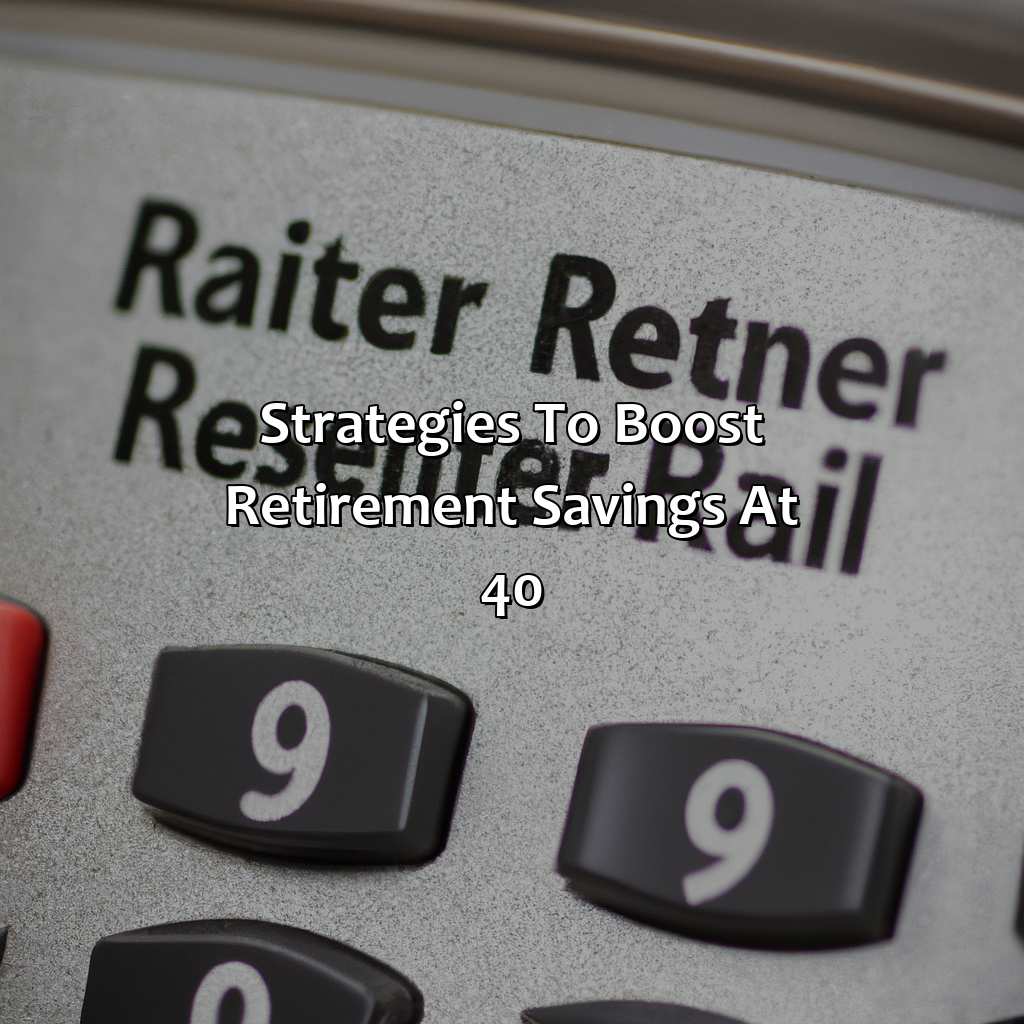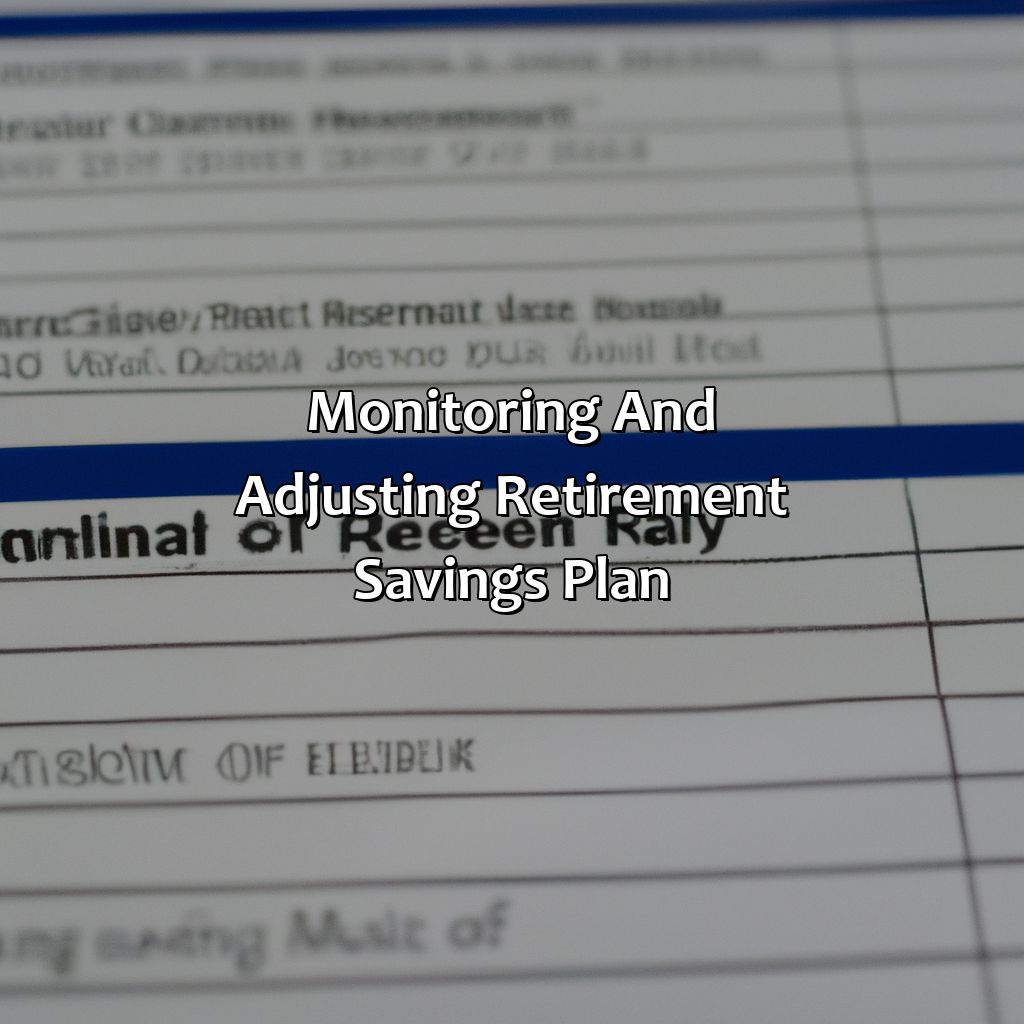How Much Should I Have Saved For Retirement At 40?
Key Takeaway:
- Assess your retirement needs: Identify your retirement goals and lifestyle, estimate your retirement expenses, and determine your potential sources of retirement income. This will help you calculate your retirement savings needs at 40 and make a plan to achieve those goals.
- Calculating your retirement savings targets: Determine how much you need to save for retirement based on your retirement goals, expected retirement expenses, and potential sources of retirement income. Factors such as your age, retirement age, and investment returns will also affect your retirement savings needs.
- Boosting retirement savings at 40: Consider increasing your retirement savings contributions, exploring alternative retirement savings vehicles, and adjusting your retirement goals and lifestyle to help you save more for retirement.
Are you turning 40 and wondering how much you should have saved for retirement? You may worry that you’re not prepared enough, but you’re not alone. This article will provide guidance to help you plan for retirement and guide you to make the most of your savings.
Assessing Retirement Needs at 40
At 40, you need to find out what type of retirement lifestyle you want and how much it’ll cost. Work out potential income sources too. We can help you get ready for retirement with these tips!

Image credits: retiregenz.com by James Arnold
Identifying Retirement Goals and Lifestyle
Retirement Planning Based on Desired Lifestyle. It is important to identify and assess your retirement goals and desired lifestyle in order to plan for a comfortable retirement. Consider factors such as inflation, healthcare costs, and living expenses in retirement. Use online calculators or consult with professionals to determine the amount of savings needed to meet your goals.
It’s also advisable to have a backup plan in case unforeseen circumstances arise. Adjust your lifestyle, if necessary, by downsizing or reducing expenses to achieve comfort in retirement.
Take control of your future by starting early and investing in a diversified portfolio that aligns with your risk tolerance and time horizon.
Don’t procrastinate your retirement planning because every year you wait sacrifices compound interest gains in the future – ultimately putting yourself at risk of not achieving your desired level of financial security.
Remember, plan ahead so that you can enjoy the fruits of your labor later in life!
Retirement expenses are like a game of Jenga – you remove one piece and the whole tower comes crashing down.
Estimating Retirement Expenses
Determining Retirement Costs
To ensure a comfortable retirement, evaluating future expenses is key. By examining your current lifestyle and projecting for potential changes in the future, one can estimate the cost of retirement. This includes analyzing basic living expenses such as housing, healthcare and food, along with discretionary spending like travel and hobbies.
Knowing these costs is important when planning for the desired retirement age and lifestyle. By understanding how much you will need to save, you can make informed decisions about your budget and investment choices.
In addition to knowing expenses, considering factors like inflation and investment returns are essential when estimating needed savings. With a clear understanding of estimated costs over time, achieving financial security in retirement becomes feasible.
Feeling uncertain about what lies ahead during retirement can be daunting. Instead of worrying about what could have been done differently in hindsight, start now by taking control of your future finances. By prioritizing saving for your golden years today, peace of mind for tomorrow can be achievable.
Don’t worry, you’ll have plenty of retirement income sources to choose from – social security, your 401(k), and selling your organs on the black market.
Determining Retirement Income Sources
Retirement Income Sources Assessment involves identifying sustainable sources of income during post-retirement life. This includes evaluating personal savings and investments like 401(k), IRA, or Annuities, alongside federal schemes such as social security, pensions or government benefits.
The level of assessment varies depending on one’s current income, financial objective, risk tolerance and age. The earlier the evaluation is done, the easier it will be to identify gaps and take corrective measures such as investing more in high-growth assets or reducing expenses to increase funds allocation for retirement purposes.
Taking into account all these factors and ensuring a diversified portfolio with a mix of different investments can help secure post-retirement funds for individuals.
Remember that time flies by quickly and retirement may come sooner than anticipated. Don’t hesitate, assess your retirement needs today!
At 40, it’s time to face the harsh reality that your retirement plan might consist of living off your kids’ inheritance.
Estimating Retirement Savings Needs at 40
To plan for a financially secure future at age 40, it’s essential to figure out your retirement savings goals. Calculate your targets, and consider the variables that will affect your savings. To help you make smart decisions, we’ll explore each of these topics and give you a complete guide.

Image credits: retiregenz.com by Yuval Jones
Understanding Retirement Savings Goals
Retirement Savings Objectives can be crucial to a comfortable retirement. At this juncture in life, you must reorganize your financial plans and assess how much money will be necessary to fund your way of living beyond the age of 60. Planning and estimating these goals take into account several factors, for example, expected retirement age, yearly household earnings, investable assets’ value and social security spending.
To evaluate pertinent data points effectively, many use a calculation called Retirement Savings Multiple (RSM). It is based on a multiple of your income saved by an exact age. From there, adjustments can be made towards expenses like healthcare costs or vacation and investment growth rates.
It is imperative to note that individuals have unique retirement needs as everyone has different visions for their lifestyle after age 60. As such generalizations about what savings are needed may not work well in all scenarios.
Aretha Franklin, the Queen of Soul, had no written will when she passed away unexpectedly at the age of 76 from pancreatic cancer complications in August 2018. She had an estimated net worth of $80 million; however, without proper planning and estate documentation during her lifetime, little direction was given towards asset transfer posthumously.
Time to do some math and figure out how broke I’ll be in retirement.
Calculating Retirement Savings Targets
When aiming for retirement, one must always set a target for savings. But how does one determine this value? Retirement Savings Threshold estimation is critical to enabling one’s future financial goals. By computing and adhering to proper guidelines, one can aim to save a larger sum by 40 years of age.
Retirement savings prerequisites are frequently contingent on the lifestyle requirement patterns chosen after retirement. Calculating estimated expenditure per year provides the first step to determining the necessary amount of savings needed at 40 yrs. Furthermore, a key factor plays in whether investments are being made regularly and whether they have achieved sufficient returns.
In addition to targeted retirement savings estimations, it is vital to analyze what calculation strategy has been employed before taking an investing procedure decision-making process. Diversification strategies allow spread institutional investments across multiple funds with their respective costs and qualities.
To maximize this endeavor’s success, planning and rationalizing investments with each income supplement or contribution will make all the difference in achieving one’s long-term retirement goal. By employing these efficient investment principles, individuals can expect fruitful outcomes in terms of achieving or surpassing their 40-year-old retirement objective with confidence.
Getting old is inevitable, but running out of retirement savings is just plain irresponsible – let’s dive into the factors that could impact your golden years.
Factors Affecting Retirement Savings
Retirement Savings Factors
Various elements affect the amount that one should save for their retirement. These include personal factors such as age, employment status, and health status, plus external factors like inflation rates and taxation policies.
The key factors to consider include:
- Age and Income: The earlier you start saving and investing, the more money you are likely to accumulate at retirement. Additionally, your income level will determine how much you can save.
- Monthly Expenses: Your monthly expenses affect how much you can save for your retirement goals. Reducing expenses frees up more money which you can then allocate towards savings.
- Investment Returns: Higher investment returns lead to increased savings over time.
- Inflation Rates: Inflation affects the value of money over time. Therefore, your savings should grow at a rate higher than inflation to maintain their purchasing power.
- Debt Levels: High debt levels reduce available funds for investment and can adversely impact your overall financial wellbeing.
It is essential to diversify investments in various asset classes such as stocks, bonds, real estate, and precious metals. Having an emergency fund also helps in avoiding dipping into retirement savings when unexpected expenses arise.
Suggested steps include starting early, maximizing contributions to tax-deferred accounts like 401(k)s and IRAs while taking advantage of employer matching funds where possible. Additionally, tracking expenditures can aid in making adjustments where necessary.
When it comes to boosting your retirement savings in your 40s, just remember: every penny counts, and every avocado toast sacrificed is a step closer to a comfortable retirement.
Strategies to Boost Retirement Savings at 40
Boosting your retirement savings at 40? Here are some ideas! Increase contributions, look into alternative savings vehicles, and adjust your lifestyle and goals. Doing this can help you achieve the retirement lifestyle you want. Let’s discuss the potential solutions to growing your retirement fund.

Image credits: retiregenz.com by James Washington
Increasing Retirement Savings Contributions
Retirement Savings Contributions can be increased in various ways to achieve financial security. The following steps can help:
- Setting a higher contribution to 401(k) or IRA plans annually is crucial.
- Benefitting from employee matched contributions positively contributes towards long-term savings.
- Consider creating a side gig or working part-time, frequently contributing towards retirement accounts.
- Increasing investments in stocks and bonds can accrue better returns leading to more significant savings.
- Reducing household expenses in areas such as food and transportation could create surplus income for retirement savings.
Last but not least, consulting with a financial advisor to customize investment strategies is always helpful.
Furthermore, personalized contribution rate analysis and auto-escalation of deferral rate options may increase retirement savings beyond anticipated levels effectively.
It’s vital to note that even though there is no fixed correct amount one should have saved for retirement at 40 years old, according to Fidelity Investments guidelines, these individuals should have already started saving around twice their annual salary.
According to Business Insider’s report of January 2021 on retirement trends worldwide: The current average lifespan of Americans has grown by an additional two months per year for each year that goes by.
In summary, increasing retirement savings contributions can be achieved through various methods such as cutting expenses or investing further while capitalizing on employer programs and seeking professional advice. Understanding the importance of long term saving goals while adapting investment strategies might ensure better financial stability in preparation for retirement age. Time to ditch the side hustle and consider alternative retirement savings vehicles – like a sturdy 401(k) instead of a flimsy lemonade stand.
Considering Alternative Retirement Savings Vehicles
For those considering options beyond traditional retirement savings vehicles, there are several routes to explore. Consider investing in real estate or alternative investments, such as private equity or hedge funds. You could also consider contributing to a Health Savings Account (HSA) to supplement your income during retirement.
- Real Estate: Investing in property can offer passive income and long-term growth potential.
- Alternative Investments: Alternative investments, such as private equity, hedge funds, or commodities, can provide diversification from typical investment options.
- HSA Contributions: Contributing to an HSA provides tax advantages and accumulated savings can later be used for healthcare expenses during retirement.
For those who desire a more hands-on approach and are interested in investing in companies they believe align with their values and visions for the future, Socially Responsible Investing (SRI) may be an attractive option. SRI involves investing in companies that prioritize ethical practices and sustainability while offering potential financial returns.
To further boost retirement savings at age 40, it is essential to maintain a consistent saving rate of 15-20% of your income. Automating contributions towards retirement accounts and monitoring investment allocation regularly can help ensure progress towards reaching your retirement goals.
Retirement goals: live comfortably and avoid cat food diet.
Adjusting Retirement Goals and Lifestyle
As a person approaches middle age, it becomes crucial to reevaluate one’s retirement goals and lifestyle choices. Making these adjustments in time can help maintain financial stability in the later years. It is vital to understand that meeting retirement goals heavily relies on not only how much you have saved but how much you spend.
One way of adjusting your retirement goals is by considering retiring at a later age. By extending your working years, you give yourself more time to save and recover from any financial setbacks. Another method could be downsizing your home or moving to an area with a lower cost of living. This approach would reduce your expenses, allowing you to save more effectively.
Anyone looking to adjust their retirement goals must take into account how their lifestyle choices can impact their savings. For instance, cutting down on unnecessary expenditures like dining out or upgrading vehicles might free up cash that can go towards savings.
One way to stay on track towards meeting your retirement goals is by sticking to a budget strictly. Keeping tabs on expenses not only puts you in control of where your money goes but also highlights areas where money could be better allocated into savings.
By approaching retirement goals systematically, one can maintain financial stability in the long run. However, it’s essential not only to focus on investing more money into savings but also making smart lifestyle choices that support lasting success toward such ambitions.
Retirement savings plan: the only plan where checking in on it more often than your ex’s Instagram is actually a good thing.
Monitoring and Adjusting Retirement Savings Plan
Secure retirement? Monitor! Adjust! Review your progress regularly. Make changes to your savings plan. Stay on track. Make adjustments to your finances if needed. It’s key!

Image credits: retiregenz.com by Joel Woodhock
Reviewing Retirement Savings Progress Regularly
Regularly reviewing and monitoring your retirement savings plan is crucial for achieving desired financial stability post-retirement. This practice involves tracking the progress of your savings plan, making necessary adjustments, and comparing it against your retirement goals. Staying updated with your retirement savings plan helps in identifying potential gaps that can be filled up through timely action, ensuring a smooth journey towards financial independence.
As you approach the age of 40, reviewing and adjusting your retirement savings plan becomes more important than ever. This milestone highlights the importance of checking if you have saved enough to live comfortably throughout your post-retirement years. Consistent monitoring of the rate at which you are saving for retirement helps you determine whether or not you are on track to meet your target, and if not, what areas need attention.
It’s essential to remember that assessing your retirement savings should not only revolve around numbers but also focus on avoiding any unpleasant surprises later in life. Considering factors such as healthcare expenses and other unforeseen events can help increase accuracy in determining how much is needed for a comfortable post-retirement life.
Don’t leave your retirement funds to chance; it’s never too late to get started. Regularly reviewing, adjusting, and maximizing contributions towards your retirement account can positively impact financial capabilities later in life and safeguard FOMO – Financially Out-Maneuvered Offspring.
Remember, adjusting your retirement savings plan is like a game of Jenga – make the wrong move and your financial future will come crashing down.
Making Changes to Retirement Savings Plan as Needed
As one gets older, changes to retirement savings plans are inevitable. It is crucial to monitor and adjust investment strategies while keeping a close eye on the overall balance of the account. It is recommended that individuals perform regular assessments and make necessary adjustments to achieve financial goals for retirement.
To ensure maximum benefits from savings plans, one could consider investing in a tax-efficient retirement account such as a 401(k) or an IRA. If there are excess funds, set savings goals and invest wisely to reap higher returns.
Moreover, it’s wise to avoid rash decisions and seek expert advice before making changes to the existing plan. A financial advisor can help evaluate the current plan in relation to personal income, expenses, future goals, and other factors. With their expertise, one can customize strategies and rebalance investments according to changing needs.
In addition, life circumstances such as marriage or having children may impact how much one should save for retirement. Adjusting contributions early enough can help keep up with the ever-changing demands of life.
Overall, modifying a retirement savings plan is about making informed decisions based on personal financial situations. Staying proactive through regular reviews enables individuals to achieve their long-term objectives while minimizing risks associated with unforeseen financial challenges.
Some Facts About How Much Should I Have Saved for Retirement at 40:
- ✅ Financial advisors recommend having at least three times your salary saved for retirement at age 40. (Source: CNBC)
- ✅ Most Americans have less than $100,000 saved for retirement by age 40. (Source: Cheat Sheet)
- ✅ To achieve a comfortable retirement, you may need to save up to 25 times your annual expenses. (Source: Fidelity)
- ✅ Starting early and maximizing contributions can help increase your retirement savings. (Source: NerdWallet)
- ✅ Different retirement savings vehicles, such as 401(k)s and IRAs, have contribution limits and tax benefits that can impact your retirement savings. (Source: Investopedia)
FAQs about How Much Should I Have Saved For Retirement At 40?
How much should I have saved for retirement at 40?
At 40, experts recommend that you should have saved at least three times your annual income in retirement savings. This would help you maintain your lifestyle until retirement, which is generally between 62 and 67 years old.
What can happen if I have not saved enough for retirement at 40?
If you have not saved enough for retirement at 40, you may need to delay your retirement date or consider reducing your standard of living after retirement. You could also face the risk of running out of money during your retirement years.
How can I estimate how much money I need for retirement?
You can estimate how much money you need for retirement by using online retirement calculators. These tools can help you determine the amount you need to save for retirement, based on your age, income, expenses, investment returns, and other factors.
What steps can I take to increase my retirement savings at 40?
To increase your retirement savings at 40, you can take several steps such as:
- Enroll in your company’s retirement plan and contribute the maximum amount allowed.
- Open an Individual Retirement Account (IRA) and make regular contributions.
- Consider working longer and delaying your retirement date.
- Live below your means and avoid unnecessary expenses.
Is it possible to catch up on retirement savings at 40?
If you have not saved enough for retirement at 40, you can catch up by making larger contributions to your retirement accounts, taking advantage of catch-up contributions for people over 50, and adjusting your investment strategies to maximize your returns. However, the earlier you start saving for retirement, the easier it becomes to reach your savings goals.
Are there any retirement savings tips for people in their 40s?
Yes, some tips to consider include:
- Optimize your investment portfolio by diversifying your assets and minimizing risk.
- Stay up-to-date with the latest retirement savings trends and regulations.
- Maximize your employer’s contributions to your retirement plan.
- Work on paying off any high-interest debts as early as possible.








